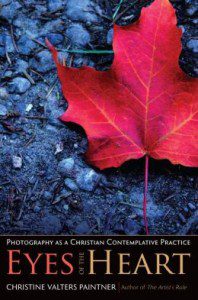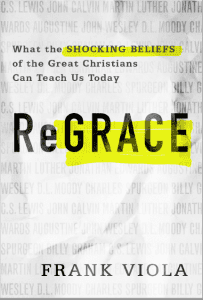 Just in time for summer – that prime season for taking and sharing photos – comes a lovely new book on photography as a spiritual practice. Eyes of the Heart: Photography as a Christian Contemplative Practice by popular spiritual director and author Christine Valters Paintner offers a prayerful twist on the everyday practice of photo-taking. For Valters Paintner, photography offers an entirely new way of seeing the world and ourselves when engaged through a contemplative lens.
Just in time for summer – that prime season for taking and sharing photos – comes a lovely new book on photography as a spiritual practice. Eyes of the Heart: Photography as a Christian Contemplative Practice by popular spiritual director and author Christine Valters Paintner offers a prayerful twist on the everyday practice of photo-taking. For Valters Paintner, photography offers an entirely new way of seeing the world and ourselves when engaged through a contemplative lens.
We sent a few questions about the book and contemplation in general across the pond to Ireland, where Christine is currently living out her calling as a “monk in the world.” (For more on Eyes of the Heart, including a guided meditation with images, visit the Patheos Book Club here.)
Eyes of the Heart is about photography as a Christian contemplative practice. To begin with, what is your description of a contemplative practice? And then specifically, what is a Christian contemplative practice?
 Carmelite monk William McNamara described contemplation as a “long loving look at the real” which I find to be an excellent foundation for understanding contemplative practice. It is long, meaning it is spacious and slow. It is loving, meaning it is full of compassion. It is a look at the real, meaning we bring our presence fully to what is actually real and true before us (rather than how we want things to be), which may not always feel beautiful, but often hard or challenging. In practicing contemplation we strive to bring a spacious, slow, attentive, and compassionate presence to everything and everyone we encounter. We try to see the truth of what is there.
Carmelite monk William McNamara described contemplation as a “long loving look at the real” which I find to be an excellent foundation for understanding contemplative practice. It is long, meaning it is spacious and slow. It is loving, meaning it is full of compassion. It is a look at the real, meaning we bring our presence fully to what is actually real and true before us (rather than how we want things to be), which may not always feel beautiful, but often hard or challenging. In practicing contemplation we strive to bring a spacious, slow, attentive, and compassionate presence to everything and everyone we encounter. We try to see the truth of what is there.
A Christian contemplative practice is rooted in one of the many contemplative strands of Christian tradition, such as the wisdom of the desert mothers and fathers, or the Benedictines, Cistercians, or many others.
In my book, I explore the Christian practice of lectio divina, which means sacred reading, and is an ancient contemplative way of reading scripture, practiced by the very early monks of our tradition, as a way of framing the practice of photography as visio divina, or sacred seeing.
From the very first pages, it’s clear that this is not a book about technique, or how to be a better photographer … but about how to ‘see’ in a new and different way. Why did you write this book? And for whom?
I wrote this book for those who want to experience art-making as a meditative practice and contemplative experience. There are so many wonderful books about photography as fine art and how to improve your technical skills, but far fewer about how photography might become a tool for seeing the world in a different way.
With the deluge of smart phones over the last couple of years, everyone seems to be taking pictures all the time, as well as sharing them with friends through social media. What makes the everyday act of photography into a contemplative practice? What’s the difference?
The central difference in photography as a contemplative practice is the intention. Outwardly it may look very similar to someone just taking photos as a way of capturing their experience.
In the book, I talk about the difference between “taking” photos, which is our common language for photography, and really how we approach much of life. Our culture encourages us to take what we need, to grasp at the things we want.
Photography, from a contemplative perspective, encourages us to “receive” rather than take. Instead of going out in the world seeking the best composition or the most beautiful image, I pay attention to what is shimmering and calling to me. I receive this as the gift that it is and respond with a sense of gratitude. When we engage photography in this way, we are left feeling full of awe and wonder at the grace and generosity of life. We pay attention to how God is speaking to us through images in the world around us.
You talk about the importance of focusing on the process of art-making rather than the product. Say a bit more about that.
This comes from my background in the expressive arts, which is a development from the field of art therapy, where creative arts are engaged in the service of healing and transformation, rather than in the fine arts field, where art is primarily for the purpose of creating something “beautiful” and often marketable.
When we focus on the process of art-making, we become attentive to all of the dimensions of what happens inside of us as we move through that process. We notice our thoughts, we become aware of judgments that arise, self-criticism, distractions. The desert mothers and fathers taught us the importance of this – to become intimately aware of the ongoing commentary we have in our thoughts at all times. Because once we are aware we can do several things: we can let the chatter go and move toward a place of inner stillness, we can become aware of how these voices affect the way we move through the whole of our lives, and we can cherish the moments when we lose ourselves in the experience and encounter that place of true freedom.
Is there a tradition of Christian contemplative photography or is it a new thing?
Thomas Merton fell in love with photography as a contemplative practice and writes about it in some of his journals. He is probably the first to articulate the connection with what is essentially a modern medium. The tradition of seeing with deepened vision goes back to the very beginnings of Christianity however.
How can photography become prayer?
Again, it is all about intention. When you go out into the world, and instead of taking photos, you wait to receive them as gift, you shift your awareness and how you move through life. This way of experiencing photography is about showing up for our experience and being attentive to all the ways we encounter the sacred in daily life. Seeing with new eyes means seeing beneath the surface of things, and cherishing the holiness of it all. This is prayer.
You have a chapter on self-portraits. How can taking pictures of ourselves – “selfies,” as one of my friends call them – be a spiritual practice?
When done with a prayerful intention, we can engage in the art of self-portrait creation as an act of compassion toward ourselves. If we return to McNamara’s definition of contemplation as a “long loving look at the real,” then we can bring that slow, spacious, compassionate gaze toward ourselves. We live in a culture where we are taught to be hyper-critical of our external appearance. There is a cultural gaze which dissects us into body parts and their various “flaws.” Through photography, we can reclaim this gaze, and begin to see ourselves through God’s eyes, with much more love and grace.
What do you love about photography?
I love the invitation to see the world with new eyes. Photography is such an accessible medium. I try to always carry a small camera with me so that I can cultivate this ability to pay attention to life as it is unfolding at all times. I love the way certain images I have received have then inspired my writing in new ways. For me, photographs and words seem to dance with one another.
Christine Valters Paintner, PhD, is the online Abbess at Abbey of the Arts, a virtual monastery and community for contemplative practice and creative expression. She is the author of seven books on art and monasticism, including her latest, Eyes of the Heart: Photography as a Christian Contemplative Practice (Ave Maria Press). Christine currently lives out her commitment as a monk in the world with her husband in Galway, Ireland.













